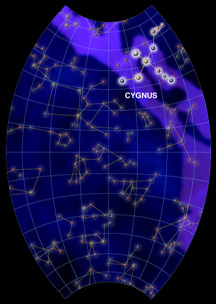The Sky This Week, 2011 December 6 – 13 — Naval Oceanography Portal
December 7th marks the beginning of the series of phenomena associated with the winter solstice. This is the evening of the year’s earliest sunset, which in the Washington, DC area occurs at 4:46 pm EST. From this evening onward Old Sol will set a little bit later on successive nights. The change is very incremental at first, but by the time the solstice occurs on the 22nd sunset will be four minutes later. By the end of the year sunset will occur at 4:58 pm. The trade-off comes with the time of latest sunrise. That won’t occur until January 4th, 2012, when the Sun peeks over the horizon at 7:27 am. The shortest day of the year still falls halfway between these dates on the solstice itself, marking the astronomical beginning to the winter season.
The Sky This Week, 2011 December 6 – 13 — Naval Oceanography Portal


 The Sky This Week, 2011 October 18 – 25 – Naval Oceanography Portal
The Sky This Week, 2011 October 18 – 25 – Naval Oceanography Portal